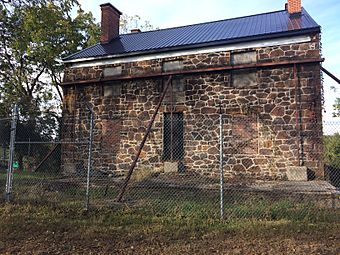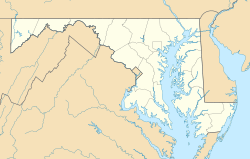Troy (Dorsey, Maryland) facts for kids
Quick facts for kids |
|
|
Troy
|
|
 |
|
| Location | Interstate 95 and Maryland Route 176 (6500 Mansion Lane), Elkridge, Maryland |
|---|---|
| Area | 50 acres (20 ha) |
| Built | 1808 |
| Architectural style | Georgian |
| NRHP reference No. | 79001137 |
| Added to NRHP | June 22, 1979 |
Troy, also known as Troy Hill Farm, is a historic home located in Elkridge, Howard County, Maryland, United States. It was once a large estate and is connected to the important Dorsey family of Howard County. This family also built another famous home called Dorsey Hall.
The Story of Troy House
The land where Troy House stands was first surveyed by Hon. John Dorsey in 1694. He moved to the property in 1696. The land stayed in the Dorsey family for many years. One family member was Col. Thomas Dorsey, who fought in the American Revolution. His estate sold the property in 1808.
The land changed hands within the Dorsey family several times. In 1760, the large property of 1,016 acres (411 ha) was divided. Thomas Dorsey, a later owner, used the home's root cellar as a secret meeting place. He met there with Benjamin Warfield from Cherry Grove during the Revolutionary War.
A stone house called "Troy Hill" was built around 1808. It was built by Vincent Baily on the foundation of an older Dorsey house. This new house shows the style of late Georgian architecture in Maryland. It is a two-and-a-half-story house made of fieldstone. It has three sections across the front and two sections deep.
The house originally had other buildings nearby. These included a stone barn, a smokehouse, and a dairy. The house sits on a hill, and its stone basement is very large, with four rooms.
Changes Over Time
In 1830, a fire damaged the house, destroying its original wood walls inside. Later, in 1880, the house was updated with a "cottage" look. It was changed again in 1942 to a "Colonial Revival" style. Another owner, Pedro De Valle, also made changes.
The state of Maryland bought the property in 1958. They planned to tear it down for the I-95 highway project. The house was left empty and uncared for. But in 1971, Howard County bought the house and 52 acres (21 ha) of land around it. They paid $67,500 for it.
In 1978, Howard County thought about turning the house into a gardening center. In 1989, the state offered money to help fix up the house. However, a fire in 1991 badly damaged the building before the repairs could start.
Troy House Today
Most of the land around Troy House has been developed. It is now covered by office parks or highways. But there is still a large wooded parkland area around the house. The Troy House itself has not been fully restored.
In 2012, County Executive Ken Ulman suggested turning the remaining land into a Tennis Center. Later, these plans changed. The idea became to clear much of the wooded area. This would make space for sports fields like ball fields and soccer fields. The Troy House would then stand in a parking lot. It might be used as a meeting place or a restaurant.
Troy House was added to the National Register of Historic Places in 1979. This list includes important historical sites in the United States. In 2015, a group called Preservation Howard County listed Troy House as one of the top 10 most endangered places. This means they believe the house is at risk and needs protection.



